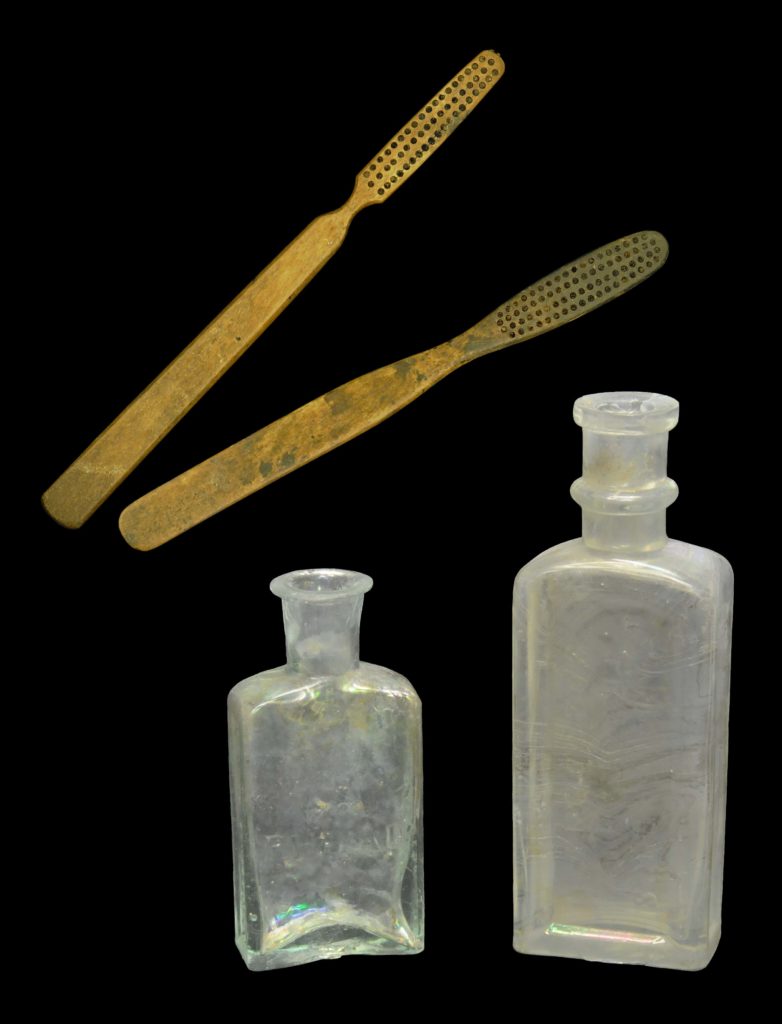
Four of the artifacts from this feature can be directly linked to oral hygiene practices in the nineteenth century. The artifacts consist of two bottles of teeth-cleaning products and the handles from two toothbrushes. Although few in number, these artifacts provide a glimpse at the dental products available as the business of caring for teeth shifted from home remedies to mass produced and marketed name brands.
One of the bottles is marked with raised lettering molded into the glass: “R.B. Da Costa,” “West Indian Toothwash,” and “Philada,” the last word a common nineteenth-century abbreviation for Philadelphia (4A-G-0081). This bottle probably dates to the third quarter of the nineteenth century, when Raphael B. Da Costa was listed in the Philadelphia city directories as a toothwash manufacturer. While the exact formula of his West Indian toothwash is not known, he may have included ingredients from the islands in his recipe or employed the term in reference to his Jamaican heritage.
The other container is a paneled bottle embossed “Van Buskirk’s Fragrant Sozodont,” probably produced between 1870 and 1885 (4A-G-0064). New Jersey druggist Roswell Van Buskirk prepared this product, which was advertised to clean and strengthen the teeth. 1 While very popular in the late nineteenth century, well before the turn of the twentieth century, dentists were warning that Sozodont actually destroyed the enamel and turned the teeth a dark yellow color. 2
The two bone-handled toothbrushes each differ slightly in appearance. One brush features a rounded square stock or bristle end with an abrupt, well-defined neck (Cat # 4.31.98). The other brush has an elliptical stock, gradual neck, with a straight shaft marked “EXCELSIOR FRANCE”(Cat # 4.24.538). Currently, no additional information is available on this manufacturer, although a different style of brush with the same mark is in the collections of Pamplin Historical Park, Petersburg, Virginia.
These toothbrush handles were probably made from cow bones, and once contained bristles made from animal hair, most likely boar. Although other materials were used for bristles, boar’s hair was the most common material used prior to the advent of nylon in 1938. The Sears Roebuck and Company catalog of 1897 also advertised imported badger hair bristles and “pure white French bristles,” both of which made the brushes significantly more expensive. 3 The stylistic elements of the two excavated toothbrushes indicate that they were likely manufactured in the late nineteenth century.
The modern form of the toothbrush was introduced in England in 1780, but remained an imported luxury item through the first quarter of the nineteenth century. Less expensive brushes were available in the 1830s and 1840s, becoming widely purchasable after the American Civil War. Household health and advice books throughout the nineteenth century encouraged brushing the teeth after meals and before bed. 4 In an article entitled “The Tooth brush – Its Influence upon the Teeth,” published in Philadelphia in The Dental Quarterly, Dr. Ambler Tees addressed the concerns of other members of the dental profession regarding the potential “mechanical abrasion of the enamel” resulting from the use of a toothbrush. 5 He argued that the effects of brushing were treatable and recommended brushing “at least once a day, although twice—before breakfast and on retiring—is more advisable.” 6
Bone brushes such as these would have been in active use for a short period of time, typically only three to four months. 7 The hair bristles would have quickly deteriorated and the bone frequently developed foul odors after a period of use. The Montgomery Ward & Company spring and summer of 1895 catalog suggested that putting wet brushes away was the primary cause of the bristles being “injured,” the bone splitting and becoming “offensive to the smell, and discolored.” 8 The same catalog recommended that worn bristles be trimmed rather than being drawn out to prolong the life of the brush, but also advised that “It is wiser to throw an old brush away than be annoyed in trying to make it last a while longer.” 9 Because these two brushes are relatively plain, it seems unlikely that effort was expended to replace the bristles, and prolong the use. By the mid-1920s, the use of bone in toothbrushes had declined significantly, primarily due to the development of synthetics, such as celluloid and plastics.
The presence of the dental hygiene products and the two toothbrushes shows that members of the household participated in the dental hygiene practices of the nineteenth century. The “Excelsior” brush, in particular, likely represents a more expensive French product and possibly a greater investment in oral hygiene by the occupants of 1018 Palmer.
References
- Caswell A. Mayo, ed., American Druggist and Pharmaceutical Record: A Semi-Monthly Illustrated Journal of Practical Pharmacy (New York, NY: American Druggist Publishing Company, 1902), 346. ↩
- C. W. Spalding, ed., The Missouri Dental Journal: A Monthly Record of Dental Science and Art (Saint Louis, MO: Maynard and Tedford, Saint Louis, 1880), 174. ↩
- Barbara E. Mattick, A Guide to Bone Toothbrushes of the 19th and Early 20th Centuries (Thorofare, NJ: Edwards Brothers, Inc., 2010), 4; Sears, Roebuck, Sears, Roebuck Catalogue, 1897 Edition (New York, NY: Republished by Chelsea House, 1968), 328. ↩
- Lydia Child, The Family Nurse (Boston, MA: C.J. Hendee, 1837; Reprint, Bedford, MA: Applewood Books, 1997), 6; Bloomfield Moore, Sensible Etiquette of the Best Society, Customs, Manners, Morals and Home Culture (Philadelphia, PA: Porter and Coates, 1878; Reprint, Forgotten Books, 2012), 260; Catherine Esther Beecher and Harriet Beecher Stowe, The American Woman’s Home (New York, NY: J. B. Ford and Company, 1869), 273, accessed August 15, 2013, http://digital.lib.msu.edu/projects/cookbooks/html/authors/author_beecher.html. ↩
- Ambler Tees, “The Tooth Brush – Its Influence Upon the Teeth,” The Dental Quarterly 5, 2 (1866): 49, accessed August 2013, http://books.google.com/books?id=RqkRAAAAYAAJ&pg=RA3-PA49&lpg=RA3-PA49&dq=The+dental+quarterly+1866+The+toothbrush+and+its+influence+upon+the+teeth&source=bl&ots=_7Xrl-hgfM&sig=hDSmgm5H2bxlyDjIJfvZ4O-eH0M&hl=en&sa=X&ei=D0G0U4-XG7egsQSB8oD4Bg&ved=0CBQQ6AEwAA#v=onepage&q=The%20dental%20quarterly%201866%20The%20toothbrush%20and%20its%20influence%20upon%20the%20teeth&f=false. ↩
- Tees, “The Tooth Brush,” 50. ↩
- Tees, “The Tooth Brush,” 50. ↩
- Montgomery Ward & Co., Montgomery Ward & Co. Catalogue and Buyers’ Guide Spring & Summer 1895 (New York, NY: Dover Publications, Inc., 1969), 103. ↩
- Montgomery Ward & Co. Catalogue, 103. ↩







